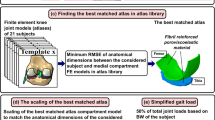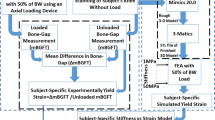Abstract
Purpose
We aim to quantitatively characterise the knee joint function in vivo under body-weight-bearing conditions via subject-specific models extracted from magnetic resonance (MR) data, in order to better understand the knee joint kinematic function in 3D.
Methods
Six healthy volunteers without any record of knee abnormality were scanned using a combined MR imaging strategy to record quasi-squatting motion and 3D knee anatomy. After a semi-automatic segmentation to delineate tibio-femoral articulation components, motion data were mapped to the anatomical data using a bi-rigid registration in order to achieve six degrees of freedom. The individual knee joint function was characterised by analysing the tibio-femoral articulation contact mechanism based on the reconstructed models in 3D and MR images in 2D. Contact points were extracted and their trajectory was plotted on the tibia plateau.
Results
The 3D models clearly show the relative rotation and gliding between tibia and femur during global flexion. Within the measured flexion arc, the contact points move less between 30\(^{\circ }\) and 100\(^{\circ }\) on both tibial plateaux as compared to that on the rest of the flexion arc. Four out of the six volunteers showed a global pattern of less moving extent of contact points on the medial tibial plateau than on the lateral tibial plateau in both 3D and 2D.
Conclusion
The proposed subject-specific model is able to characterise knee joint kinematic function. It provides a way to describe knee joint surface kinematics quantitatively, which may help to better understand the knee function and joint derangements.





Similar content being viewed by others
References
Williams A, Logan M (2004) Understanding tibio-femoral motion. Knee 11:81–88
Herzog W, Federico S (2006) Considerations on joint and articular cartilage mechanics. Biomech Model Mechanobiol 5:64–81
Lu T-W, Tsai T-Y, Kuo M-Y, Hsu H-C, Chen H-L (2008) In vivo three-dimensional kinematics of the normal knee during active extension under unloaded and loaded conditions using single-plane fluoroscopy. Med Eng Phys 30:1004–1012
Varadarajan KM, Moynihan AL, D’Lima D, Colwell CW, Li G (2008) In vivo contact kinematics and contact forces of the knee after total knee arthroplasty during dynamic weight-bearing activities. J Biomech 41:2159–2168
Blankevoort L, Huiskes R (1996) Validation of a three-dimensional model of the knee. J Biomech 29:955–961
Wilson D, Feikes J, Zavatsky A, O’Connor J (2000) The components of passive knee movement are coupled to flexion angle. J Biomech 33:465–473
Caruntu DI, Hefzy MS (2004) 3-D anatomically based dynamic modeling of the human knee to include tibio-femoral and patello-femoral joints. J Biomech Eng 126:44–53
DeFrate LE, Sun H, Gill TJ, Rubash HE, Li G (2004) In vivo tibiofemoral contact analysis using 3D MRI-based knee models. J Biomech 37:1499–1504
Pinskerova V, Johal P, Nakagawa S, Sosna A, Williams A, Gedroyc W, Freeman MAR (2004) Does the femur roll-back with flexion? J Bone Joint Surg Br 86:925–931
Abdel-Rahman EM, Hefzy MS (1998) Three-dimensional dynamic behaviour of the human knee joint under impact loading. Med Eng Phys 20:276–290
Li G, Suggs J, Gill T (2002) The effect of anterior cruciate ligament injury on knee joint function under a simulated muscle load: a three-dimensional computational simulation. Ann Biomed Eng 30: 713–720
Fernandez JW, Pandy MG (2006) Integrating modelling and experiments to assess dynamic musculoskeletal function in humans. Exp Physiol 91:371–382
Küpper JC, Loitz-Ramage B, Corr DT, Hart DA, Ronsky JL (2007) Measuring knee joint laxity: a review of applicable models and the need for new approaches to minimize variability. Clin Biomech 22:1–13
Iwaki H, Pinskerova V, Freeman MA (2000) Tibiofemoral movement 1: the shapes and relative movements of the femur and tibia in the unloaded cadaver knee. J Bone Joint Surg Br 82:1189–1195
Wretenberg P, Ramsey DK, Németh G (2002) Tibiofemoral contact points relative to flexion angle measured with MRI. Clin Biomech (Bristol, Avon) 17:477–485
Li G, Wuerz TH, DeFrate LE (2004) Feasibility of using orthogonal fluoroscopic images to measure in vivo joint kinematics. J Biomech Eng 126:314–318
Johal P, Williams A, Wragg P, Hunt D, Gedroyc W (2005) Tibio-femoral movement in the living knee. A study of weight bearing and non-weight bearing knee kinematics using “interventional” MRI. J Biomech 38:269–276
Chen B, Lambrou T, Offiah A, Fry M, Todd-Pokropek A (2011) Combined MR imaging towards subject-specific knee contact analysis. Visual Comput 27:121–128
Hoppe H (2008) Poisson surface reconstruction and its applications. In: SPM ’08: proceedings of the 2008 ACM symposium on solid and physical modeling, ACM, New York, p 10
CNR, V.C.L.S.: MeshLab, http://meshlab.sourceforge.net/ (2009)
Medical, M.: MITK 3M3, http://mint-medical.de/productssolutions/mitk3m3/mitk3m3/ (2009)
Yoshioka Y, Siu D, Cooke TD (1987) The anatomy and functional axes of the femur. J Bone Joint Surg Am 69:873–880
Yoshioka Y, Siu DW, Scudamore RA, Cooke TD (1989) Tibial anatomy and functional axes. J Orthop Res 7:132–137
Périé D, Hobatho MC (1998) In vivo determination of contact areas and pressure of the femorotibial joint using non-linear finite element analysis. Clin Biomech 13:394–402
Patel VV, Hall K, Ries M, Lotz J, Ozhinsky E, Lindsey C, Lu Y, Majumdar S (2004) A three-dimensional MRI analysis of knee kinematics. J Orthop Res 22:283–292
Shin CS, Souza RB, Kumar D, Link TM, Wyman BT, Majumdar S (2011) In vivo tibiofemoral cartilage-to-cartilage contact area of females with medial osteoarthritis under acute loading using MRI. J Mag Reson Imaging 34:1405–1413
Hill PF, Vedi V, Williams A, Iwaki H, Pinskerova V, Freeman MA (2000) Tibiofemoral movement 2: the loaded and unloaded living knee studied by MRI. J Bone Joint Surg Br 82:1196–1198
Nakagawa S, Kadoya Y, Todo S, Kobayashi A, Sakamoto H, Freeman MA, Yamano Y (2000) Tibiofemoral movement 3: full flexion in the living knee studied by MRI. J Bone Joint Surg Br 82: 1199–1200
Karrholm J, Brandsson S, Freeman MA (2000) Tibiofemoral movement 4: changes of axial tibial rotation caused by forced rotation at the weight-bearing knee studied by RSA. J Bone Joint Surg Br 82:1201–1203
Yao J, Lancianese SL, Hovinga KR, Lee J, Lerner AL (2008) Magnetic resonance image analysis of meniscal translation and tibio-menisco-femoral contact in deep knee flexion. J Orthopaedic Res 26:673–684
Kim W, Richards J, Jones RK, Hegab A (2004) A new biomechanical model for the functional assessment of knee osteoarthritis. Knee 11:225–231
Acknowledgments
This work is funded by European project ‘3D Anatomic Human’, project number ‘MRTN-CT-2006-035763’. The authors would like to thank Prof. Waldy Gedroyc, Mr Warren Casperz and Ms Lauren Suhdblom for their advice on data acquisition and contact analysis.
Author information
Authors and Affiliations
Corresponding author
Rights and permissions
About this article
Cite this article
Chen, B., Lambrou, T., Offiah, A.C. et al. An in vivo subject-specific 3D functional knee joint model using combined MR imaging. Int J CARS 8, 741–750 (2013). https://doi.org/10.1007/s11548-012-0801-7
Received:
Accepted:
Published:
Issue Date:
DOI: https://doi.org/10.1007/s11548-012-0801-7




